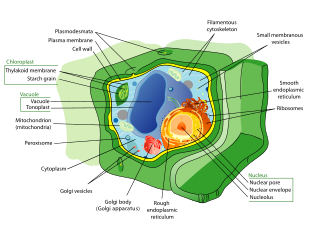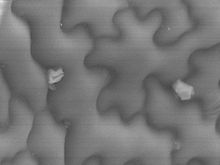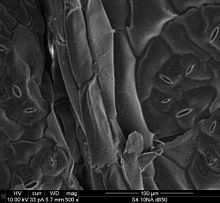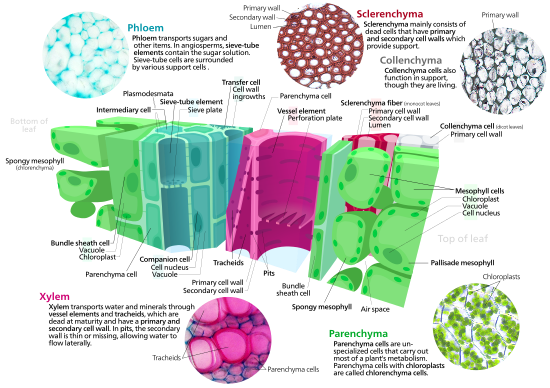Plant cell

Plant cells are the cells present in green plants, photosynthetic eukaryotes of the kingdom Plantae. Their distinctive features include primary cell walls containing cellulose, hemicelluloses and pectin, the presence of plastids with the capability to perform photosynthesis and store starch, a large vacuole that regulates turgor pressure, the absence of flagella or centrioles, except in the gametes, and a unique method of cell division involving the formation of a cell plate or phragmoplast that separates the new daughter cells.
Characteristics of plant cells
- Plant cells have cell walls composed of cellulose, hemicelluloses, and pectin and constructed outside the cell membrane. Their composition contrasts with the cell walls of fungi, which are made of chitin, of bacteria, which are made of peptidoglycan and of archaea, which are made of pseudopeptidoglycan. In many cases lignin or suberin are secreted by the protoplast as secondary wall layers inside the primary cell wall. Cutin is secreted outside the primary cell wall and into the outer layers of the secondary cell wall of the epidermal cells of leaves, stems and other above-ground organs to form the plant cuticle. Cell walls perform many essential functions. They provide shape to form the tissue and organs of the plant, and play an important role in intercellular communication and plant-microbe interactions.[1] The cell wall is flexible during growth and has small pores called plasmodesmata that allow the exchange of nutrients and hormones between cells.[2]
- Many types of plant cells contain a large central sap, stores useful material such as phosphorus and nitrogen[4] and digests waste proteins and organelles.
- Specialized cell-to-cell communication pathways known as plasmalemma and endoplasmic reticulum[6]of adjacent cells are continuous.
- Plant cells contain mitochondria, which have a genome encoding 37 genes,[8] plastids have their own genomes of about 100–120 unique genes[9] and are interpreted as having arisen as prokaryotic endosymbionts living in the cells of an early eukaryotic ancestor of the land plants and algae.[10]
- Cell division in land plants and a few groups of algae, notably the Charophytes[11] and the Chlorophyte Order Trentepohliales,[12] takes place by construction of a phragmoplast as a template for building a cell plate late in cytokinesis.
- The motile, free-swimming
Types of plant cells and tissues
Plant cells differentiate from undifferentiated meristematic cells (analogous to the stem cells of animals) to form the major classes of cells and tissues of roots, stems, leaves, flowers, and reproductive structures, each of which may be composed of several cell types.
Parenchyma
Collenchyma
Collenchyma cells are typically quite elongated, and may divide transversely to give a septate appearance. The role of this cell type is to support the plant in axes still growing in length, and to confer flexibility and tensile strength on tissues. The primary wall lacks lignin that would make it tough and rigid, so this cell type provides what could be called plastic support – support that can hold a young stem or petiole into the air, but in cells that can be stretched as the cells around them elongate. Stretchable support (without elastic snap-back) is a good way to describe what collenchyma does. Parts of the strings in celery are collenchyma.Sclerenchyma

Xylem
Phloem

Epidermis
The
See also
- Animal cell
- Chromatin
- Cytoplasm
- Chloroplast
- Cytoskeleton
- Nuclear membrane
- Leucoplast
- Golgi Bodies
- Nucleus
- Nucleolus
- Mitochondrion
- Wall-associated kinase
- Paul Nurse
References
- PMID 20921169.
- ISBN 978-1-64693-728-8.
- ISBN 9780120059256.
- .
- PMID 8318697.
- S2CID 8650433.
- ^ Bassham, James Alan; Lambers, Hans, eds. (2018). "Photosynthesis: importance, process, & reactions". Encyclopedia Britannica. Retrieved 2018-04-15.
- S2CID 4355527.
- PMID 16381961.
- ISBN 978-0300013535.
- PMID 21652308.
- PMID 14657098.
- PMID 11743094.
- .
- JSTOR 3224266.
- ISBN 9780716762843.
- ^ G., Haberlandt (1902). "Kulturversuche mit isolierten Pflanzenzellen". Mathematisch-naturwissenschaftliche. 111 (1). Akademie der Wissenschaften in Wien Sitzungsberichte: 69–92.
- OCLC 1122454203.)
{{cite book}}: CS1 maint: location missing publisher (link - ^ ISBN 0713126388.
- ASIN B0007J57W0.
- ^ MT Tyree; MH Zimmermann (2003) Xylem structure and the ascent of sap, 2nd edition, Springer-Verlag, New York USA
- environmental stresses. In: Plant Cuticles. Ed. by G. Kerstiens, BIOS Scientific publishers Ltd., Oxford, pp 83–108

